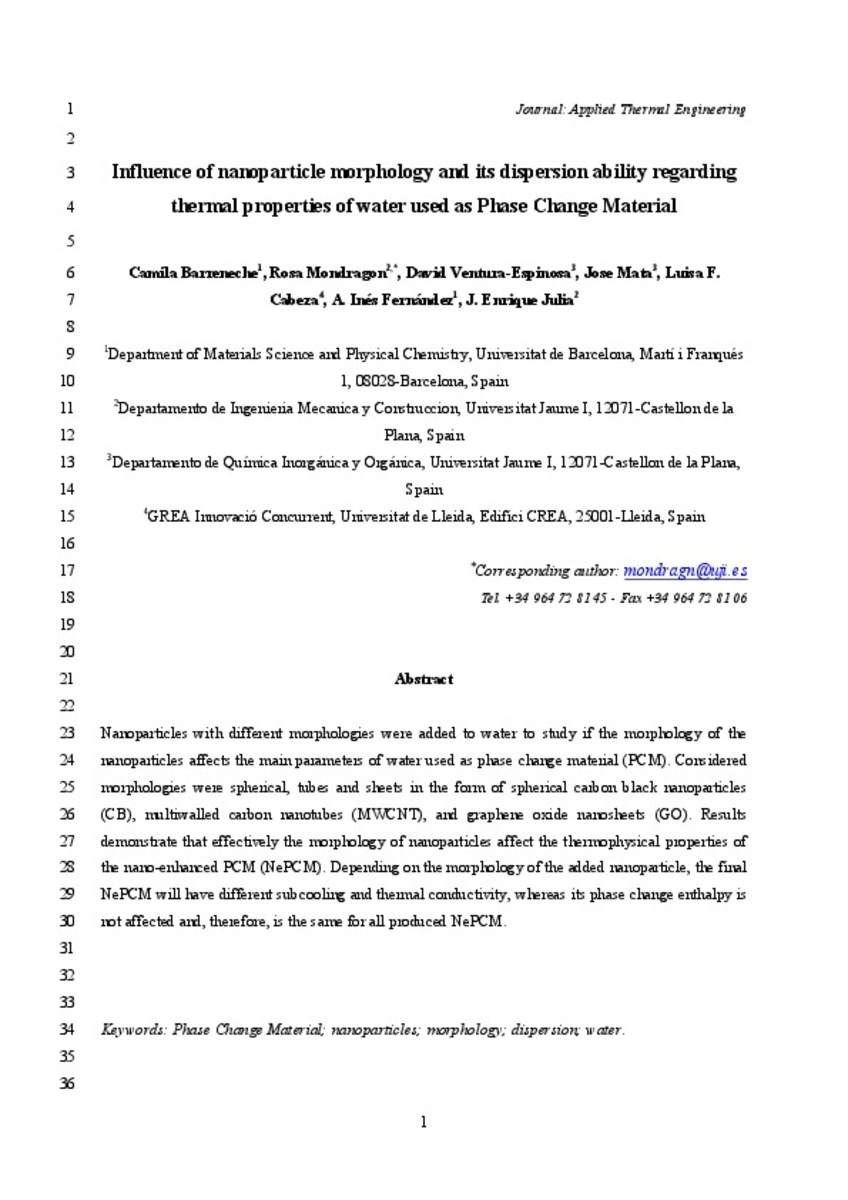Mostrar el registro sencillo del ítem
Influence of nanoparticle morphology and its dispersion ability regarding thermal properties of water used as phase change material
| dc.contributor.author | Barreneche, Camila | |
| dc.contributor.author | Mondragon, Rosa | |
| dc.contributor.author | Ventura Espinosa, David | |
| dc.contributor.author | Mata Martínez, Jose A | |
| dc.contributor.author | CABEZA, LUISA F. | |
| dc.contributor.author | Fernández, A. Inés | |
| dc.contributor.author | Juliá Bolívar, José Enrique | |
| dc.date.accessioned | 2018-04-25T07:21:43Z | |
| dc.date.available | 2018-04-25T07:21:43Z | |
| dc.date.issued | 2018-01-05 | |
| dc.identifier.citation | BARRENECHE, Camila, et al. Influence of nanoparticle morphology and its dispersion ability regarding thermal properties of water used as phase change material. Applied Thermal Engineering, 2018, vol. 128, p. 121-126. | ca_CA |
| dc.identifier.issn | 1359-4311 | |
| dc.identifier.issn | 1873-5606 | |
| dc.identifier.uri | http://hdl.handle.net/10234/174314 | |
| dc.description.abstract | Nanoparticles with different morphologies were added to water to study if the morphology of the nanoparticles affects the main parameters of water used as phase change material (PCM). Considered morphologies were spherical, tubes and sheets in the form of spherical carbon black nanoparticles (CB), multiwalled carbon nanotubes (MWCNT), and graphene oxide nanosheets (GO). Results demonstrate that effectively the morphology of nanoparticles affect the thermophysical properties of the nano-enhanced PCM (NePCM). Depending on the morphology of the added nanoparticle, the final NePCM will have different subcooling and thermal conductivity, whereas its phase change enthalpy is not affected and, therefore, is the same for all produced NePCM. | ca_CA |
| dc.format.extent | 6 p. | ca_CA |
| dc.format.mimetype | application/pdf | ca_CA |
| dc.language.iso | eng | ca_CA |
| dc.relation.isPartOf | Applied Thermal Engineering, 2018, vol. 128 | ca_CA |
| dc.rights | Copyright © Elsevier B.V. | ca_CA |
| dc.rights.uri | http://rightsstatements.org/vocab/InC/1.0/ | * |
| dc.subject | phase change material | ca_CA |
| dc.subject | nanoparticles | ca_CA |
| dc.subject | morphology | ca_CA |
| dc.subject | dispersion | ca_CA |
| dc.subject | water | ca_CA |
| dc.title | Influence of nanoparticle morphology and its dispersion ability regarding thermal properties of water used as phase change material | ca_CA |
| dc.type | info:eu-repo/semantics/article | ca_CA |
| dc.identifier.doi | https://doi.org/10.1016/j.applthermaleng.2017.09.014 | |
| dc.rights.accessRights | info:eu-repo/semantics/openAccess | ca_CA |
| dc.relation.publisherVersion | https://www.sciencedirect.com/science/article/pii/S1359431117303320#! | ca_CA |
| dc.date.embargoEndDate | 2020-01-05 | |
| dc.contributor.funder | The research leading to these results has received funding from the European Commission Seventh Framework Programme (FP/2007-2013) under grant agreement n° PIRSES-GA-2013-610692 (INNOSTORAGE) and from the European Union’s Horizon 2020 research and innovation program under grant agreement No 657466 (INPATH-TES). The authors would like to thank the Catalan Government for the quality accreditation given to their research groups GREA (2014 SGR 123), DIOPMA (2014 SGR 1543). This work has been partially funded by the Spanish government (ENE2015-64117-C5-1-R (MINECO/FEDER) and ENE2015-64117-C5-2-R (MINECO/FEDER)). Dr. Camila Barreneche would like to thank Ministerio de Economia y Competitividad de España for Grant Juan de la Cierva FJCI-2014-22886. This work has been developed by participants of the COST Action CA15119 Overcoming Barriers to Nanofluids Market Uptake (NANOUPTAKE). | ca_CA |
| dc.type.version | info:eu-repo/semantics/submittedVersion | ca_CA |
Ficheros en el ítem
Este ítem aparece en la(s) siguiente(s) colección(ones)
-
QUIO_Articles [690]
Articles de publicacions periòdiques -
EMC_Articles [807]







